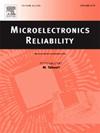Modified TCAD simulation approach for 4H-SiC JBS diode to investigate electron trapping effects
IF 1.9
4区 工程技术
Q3 ENGINEERING, ELECTRICAL & ELECTRONIC
引用次数: 0
Abstract
A modified TCAD approach is developed for 4H-SiC junction barrier Schottky (JBS) diode by placing distinct contacts to the Schottky barrier diode (SBD) and PN junction regions. Like reality, if a common metal contact with work function is specified for top electrode, TCAD model simulates back-to-back serially connected metal/p+-type Schottky and PN junction characteristics at the PN regions. Hence, the conventional contact definition simulates only the SBD characteristics with the reduced active area, while PN junctions remain inactive. Using modified contact strategy, the simulated forward I-V is matched with the measurements, and the SBD and PN diode current components are disassociated. The peak electric field occurs at the PN junction during reverse bias; however, reverse current is entirely caused by SBD tunneling current, thereby realizing the typical JBS diode operation. Trap-assisted tunneling (TAT) current induced by omnipresent electron traps (EC – 0.19 eV, EC – 0.65 eV, and EC – 1.65 eV) in 4H-SiC is explored for JBS diodes. The reverse I-V is eventually validated using non-local tunneling model. The TCAD simulations are extended to investigate the electron trapping effects on the I-V properties with increasing trap concentrations. Consequently, the trapping-induced changes in the internal device parameters are probed to correlate with the macroscopic variation in the diode characteristics.
改进的4H-SiC JBS二极管TCAD仿真方法研究电子俘获效应
通过在肖特基势垒二极管(SBD)和PN结区域放置不同的触点,开发了一种改进的4H-SiC势垒肖特基(JBS)二极管的TCAD方法。与实际情况类似,如果顶部电极指定一个具有功函数的公共金属触点,TCAD模型在PN区域模拟背靠背串行连接的金属/p+型肖特基和PN结特性。因此,传统的接触定义只模拟了活性面积减少的SBD特性,而PN结保持非活性。采用改进的接触策略,模拟的正向I-V与测量值相匹配,SBD和PN二极管电流分量分离。反向偏压时,峰值电场出现在PN结处;而反向电流完全由SBD隧穿电流引起,从而实现了典型的JBS二极管工作。研究了JBS二极管在4H-SiC中普遍存在的电子阱(EC - 0.19 eV, EC - 0.65 eV和EC - 1.65 eV)诱导的阱辅助隧穿(TAT)电流。最后利用非局部隧道模型验证了反向I-V。扩展了TCAD模拟,以研究随着陷阱浓度的增加,电子捕获对I-V性能的影响。因此,研究了捕获引起的器件内部参数变化与二极管特性的宏观变化之间的关系。
本文章由计算机程序翻译,如有差异,请以英文原文为准。
求助全文
约1分钟内获得全文
求助全文
来源期刊

Microelectronics Reliability
工程技术-工程:电子与电气
CiteScore
3.30
自引率
12.50%
发文量
342
审稿时长
68 days
期刊介绍:
Microelectronics Reliability, is dedicated to disseminating the latest research results and related information on the reliability of microelectronic devices, circuits and systems, from materials, process and manufacturing, to design, testing and operation. The coverage of the journal includes the following topics: measurement, understanding and analysis; evaluation and prediction; modelling and simulation; methodologies and mitigation. Papers which combine reliability with other important areas of microelectronics engineering, such as design, fabrication, integration, testing, and field operation will also be welcome, and practical papers reporting case studies in the field and specific application domains are particularly encouraged.
Most accepted papers will be published as Research Papers, describing significant advances and completed work. Papers reviewing important developing topics of general interest may be accepted for publication as Review Papers. Urgent communications of a more preliminary nature and short reports on completed practical work of current interest may be considered for publication as Research Notes. All contributions are subject to peer review by leading experts in the field.
 求助内容:
求助内容: 应助结果提醒方式:
应助结果提醒方式:


